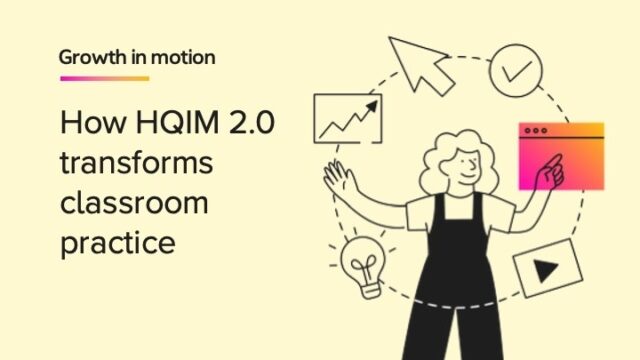
In a school setting, students have the support of their teachers. And sometimes, teachers and administrators need support from an instructional coach! In my years working at HMH, I have seen both the power of high-quality professional development and the range of what it can look like, and coaching is a great option. Coaches use instructional coaching models to provide a framework for support and actionable ways to help increase student outcomes.
The HMH coaching team believes coaching is a shared learning journey with teachers in the driver’s seat. Successful coaching gives teachers ownership over their professional learning schedule with a dedicated instructional coach to help them refine their teaching instruction and make a positive impact on student learning. HMH Coachly’s™ framework for instructional coaching promotes a unified teaching culture and a shared approach to setting, measuring, and achieving professional goals. This approach can foster teamwork and a positive school culture in addition to providing instructional support.
If your school or district is looking to implement an instructional coach, it helps to know what the different types of educational coaching are and how they might fit into your school culture.
Different Types of Educational Coaching Models
There are several different coaching models in education. Below are a few that are commonly used in school districts; these are a great place to start when exploring educational coaching models.
Directive Coaching
Directive coaching is used when an instructional coach supports a teacher through direct advice and suggestions on how to tackle a problem. If the coach has expertise in a certain subject, this approach might work well, but it is not collaborative. Some examples of coaching using this method would be in a lecture setting or Q&A session.
Non-Directive Coaching
Non-directive coaching, in contrast, assumes that the teacher or administrator holds the answers to questions that need solving. However, the coach can act as a guide to support them as they make decisions. This strategy can be helpful when the staff has a large goal that does not have one right answer. One way a coach can assist is to help staff members understand what resources they have available that can support them in reaching their goals. Then, they could work through school data and current work processes to guide them to reach their goal.
Partner-Based Coaching
Sometimes referred to as collaborative coaching, this type of coaching encourages coaches and teachers to work together to design and apply learning based on personalized goals and growth-oriented metrics.
In Coachly, teachers can work within the HMH Coaching Framework to first select an instructional domain where they need support. Then, they will narrow their focus to a topic aligned with the teacher’s goals. Following this initial goal setting, they will meet 1:1 to review strategies to meet their goals. As they continue working, they have constant support from their coach through meetings, online messaging, and coach-provided resources to improve their teaching practice. This is an example of partner-based coaching where teachers can get continuous support as they tackle new challenges throughout the school year.
Within partner-based coaching, there are various approaches that an instructional coach can take to help teachers and administrators come up with a plan to reach their goals. Coaches and teachers can use one or all of these approaches to work toward their goal of improving student outcomes. Below are a few different approaches:
- Facilitative: This approach supports teachers through active listening and asking important questions that will refine the path forward.
- Collaborative: Work together as a team to identify the focus of your coaching sessions and put your shared expectations in writing to foster collaboration.
- Responsive: Align your goals with the school’s needs and pivot to meet evolving needs. Being flexible to change can help improve outcomes and encourage a responsive approach.
- Reflective: Set data-informed, student-centered goals at the beginning of the coaching cycle and then reflect on your progress. Continue to revisit your goals to align the next instructional steps.

Teacher Coaching Model vs. Coach-Led Model
While both teacher coaching models and coach-led models have their benefits, teacher-led coaching models encourage more collaboration between teachers and coaches to achieve their goals.
Teacher coaching models help to develop a plan for an individual teacher. A teacher might need help with lesson planning for a class or implementing a new initiative at the school. The goal of this method is to guide teachers through changes and the specific challenges in which they need support.
Coach-led models center on the expertise that a certain coach can give in a specific area. This approach is more like directive coaching and is for coaches to give teachers guidance on a topic on which the coaches are experts. For example, they may be an expert in securing funding for projects and can help a teacher or school district tackle their fundraising goals.
There’s also student-centered coaching, which keeps the students as the focus of the session. While students are always the inspiration behind coaching, this might include meeting monthly with a coach and discussing student-specific problems to solve. It can be beneficial to work in this kind of framework if there are a number of student issues to address.
Instructional coaching models provide a helpful way to frame how coaches can work to guide teachers and administrators. It’s important to think about how you would like to work and problem solve, and most importantly, how you would like to be supported when looking to meet your goals.
***
HMH Coachly equips educators of all experience levels with year-round support to meet their goals.
Download Building Your School Culture: An Administrator's Guide today!














